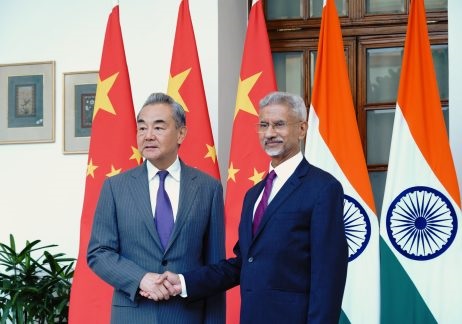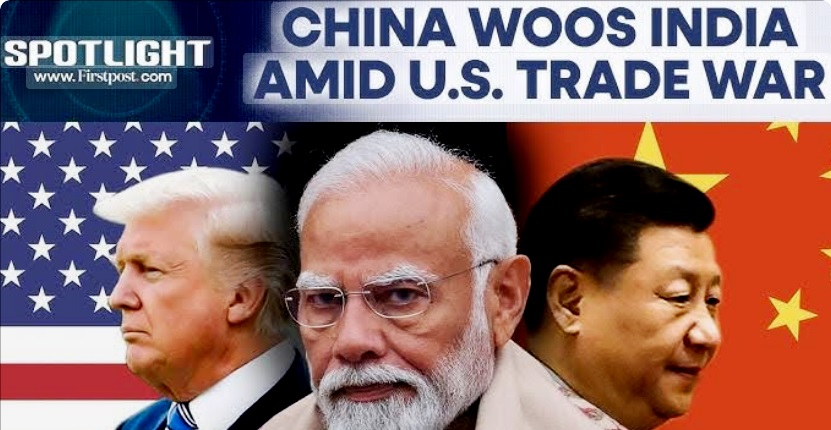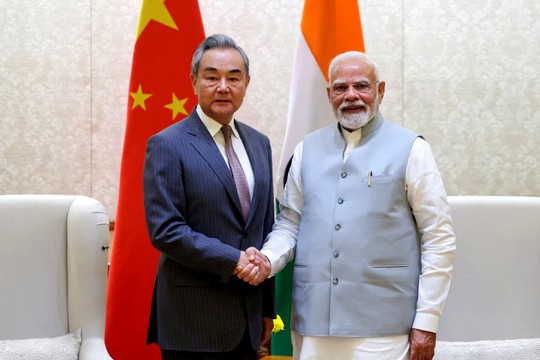India's Prime Minister Narendra Modi shakes hand with Chinese Foreign Minister Wang Yi during their meeting in New Delhi, India August 19, 2025.
Photo: India's Press Information Bureau
Indian Prime Minister Narendra Modi said on Tuesday that India-China relations had made steady progress since his meeting with Chinese President Xi Jinping in October, guided by respect for each other's interests and sensitivities, Reuters reports.
"I look forward to our next meeting in Tianjin on the sidelines of the SCO (Shanghai Cooperation Organization) Summit," Modi posted on X. "Stable, predictable, constructive ties between India and China will contribute significantly to regional as well as global peace and prosperity."
 Chinese Foreign Minister Wang Yi (left) shakes hands with Indian External Affairs Minister S. Jaishankar during a visit to New Delhi, India, Aug. 18, 2025.
Chinese Foreign Minister Wang Yi (left) shakes hands with Indian External Affairs Minister S. Jaishankar during a visit to New Delhi, India, Aug. 18, 2025.
Photo: Reuters
After more than three years, China’s top diplomat and Politburo member Wang Yi visited New Delhi this week for the 24th round of India-China Special Representative talks, writes ‘The Asia Times’.
The last round took place in December 2019, but the Galwan Valley clashes in June 2020 brought the dialogue to a halt.
Now, the tone has shifted, reflecting a cautious and potentially ground-breaking recalibration in India–China relations amid Trump’s tariff tantrum toward India. The Kazan meeting between Modi and Xi appears to have created space for tentative re-engagement and a recalibration of ties.
Moves were afoot even before Trump’s tariff tantrum toward India. In June, India’s defense minister and national security advisor visited China, followed by External Affairs Minister S Jaishankar’s trip to Beijing in July.
That bilateral momentum will build when China hosts and Modi attends the Shanghai Cooperation Organisation (SCO) summit in Tianjin this month. Significantly, it will mark the first time Modi has traveled to China since 2018.
New Delhi’s push for “Make in India” manufacturing self-reliance depends, in part, on access to Chinese industrial inputs. Beijing, meanwhile, may see an opportunity to leverage tensions in India’s ties with the US, aiming to tilt New Delhi away from Washington and reinvigorate the Russia–India–China strategic triangle.
This pragmatism reflects mutual recognition of tactical and strategic leverage points. Indian establishment voices in policymaking circles have increasingly urged joint ventures with Chinese firms that hold dominant global positions in manufacturing and supply chains.
To be sure, the bilateral thaw is delicate and tentative. Symbolic gestures — resuming direct flights, reopening the Kailash–Mansarovar pilgrimage and loosening investment restrictions — suggest movement toward normalized ties.
For India, Modi’s Atmanirbhar Bharat (self-reliant India) vision is a key driver. Unlike past Soviet-style licensed production, India today seeks technology transfers to build its manufacturing base.
But Chinese companies, like others, will tightly control how much technology crosses borders — and under what conditions. Some joint initiatives are emerging, but asymmetry in economic and technological power remains.
India, for its part, wants to diversify its technology and investment sources without becoming overly dependent on either China or the US.
And while Beijing may seek to prevent India from drifting too far into US-led geopolitical and supply chain initiatives, their diplomatic-economic-strategic balancing act remains delicate.
India continues to see China’s close relationship with Pakistan as a limiting factor in bilateral ties.
New Delhi also recognizes that Beijing may quietly welcome the recent and significant strain in US–India relations. Despite foundational defense agreements and the Initiative on Critical and Emerging Technologies (iCET), Washington remains hesitant to share advanced technologies with India.
The Trump administration’s renewed protectionist measures, not least his 50% punitive tariff on India over its purchase of sanctioned Russian oil, have made top-tier US tech-sharing even less likely.
Wang put the dispute in a broader global context, warning that the world faces “a once-in-a-century transformation at an accelerating pace,” and must resist “bullying” tactics — a not-so-veiled critique of Washington that aimed to pull India more deeply into the expanding BRICS bloc of middle powers.
Jaishankar echoed a shared call for “reformed multilateralism,” positioning India and China as powers aligned on global governance, even as their bilateral irritants remain unresolved.
Wang’s meeting with Modi also laid the diplomatic groundwork for the Indian leader’s upcoming China visit, marking perhaps the most consequential upshot of the Chinese envoy’s visit.

With Chinese Foreign Minister Wang Yi’s recent visit to New Delhi from August 18 to 20, and Indian Prime Minister Narendra Modi preparing for his first visit to China in seven years for the upcoming Shanghai Cooperation Organization (SCO) summit in Tianjin, China, the South Asian region is on the brink of significant changes, stresses ‘The Diplomat’, which covers events across the Asia-Pacific region.
Most of the analysis on the subject emphasizes the contentious history of Sino-Indian relations, but that ignores another crucial dynamic: whenever hostility between Beijing and New Delhi eases, South Asia briefly breathes a sigh of relief.
This pattern has acquired renewed significance in the current context. India’s outreach to Beijing comes at a moment of growing friction with its Western partners. Despite closer ties with Washington, New Delhi has faced repeated reminders of U.S. unreliability, such as tariffs on Indian goods, and unease in Washington over India’s continued purchase of discounted Russian oil, often seen by the U.S. as an effort toward de-dollarization. This has raised questions within the Indian political circles about whether the United States can be trusted – a perennial concern for New Delhi.
More broadly, the recent assertive diplomatic posturing evident from statements by External Affairs Minister S. Jaishankar, and intelligence adventurism abroad, especially in Western states such as Canada and the U.S., and the policy shift from nonalignment to multialignment in an era of conflict-enriched geopolitics, resulted in additional diplomatic mistrust.
This uncertainty has now compelled India to hedge its bets. India has realized that an overreliance on Washington would narrow the already closing space of New Delhi’s diplomacy, leaving India stranded. So, by moving to normalize ties with Beijing, the Modi government has not only strategically signaled that India has options beyond the U.S.
Hence, the upcoming participation of Modi in the SCO summit and a possible meeting with President Xi Jinping not only showcases India’s diplomatic isolation but also its ability to readjust as per the geopolitical reality.
If New Delhi’s strategy reflects a search for political leeway beyond the West, Beijing has its own reasons to listen. China’s strategic outlook has always been shaped by its economic aspirations and the need to secure reliable markets. And India, with its huge capital and vast consumer base, is too significant to be disregarded. Even a limited economic engagement with New Delhi could provide Beijing with a strategic advantage.
Moreover, even strategically, Beijing has every reason to cool tensions along its western border. The rivalry with the United States over Taiwan and the South China Sea already consumes a lot of its diplomatic and military resources. Easing friction with India would allow China to concentrate on its growth rather than risk being pulled into yet another crisis.
While Washington often gets credit for meditating in South Asia, especially given President Donald Trump’s newfound interest in mediation, even in the case of recent ceasefire negotiations between India and Pakistan, China has always been a parallel stabilizer: quiet, firm, and largely under-recognized but always present. In moments of crisis, Beijing has avoided theatrics and cautiously steered both rivals toward the brakes. This underappreciated dynamic suggests that if India and China move toward a thaw, Beijing will play even more of a stabilizing role in South Asia.
read more in our Telegram-channel https://t.me/The_International_Affairs

 11:04 22.08.2025 •
11:04 22.08.2025 •























